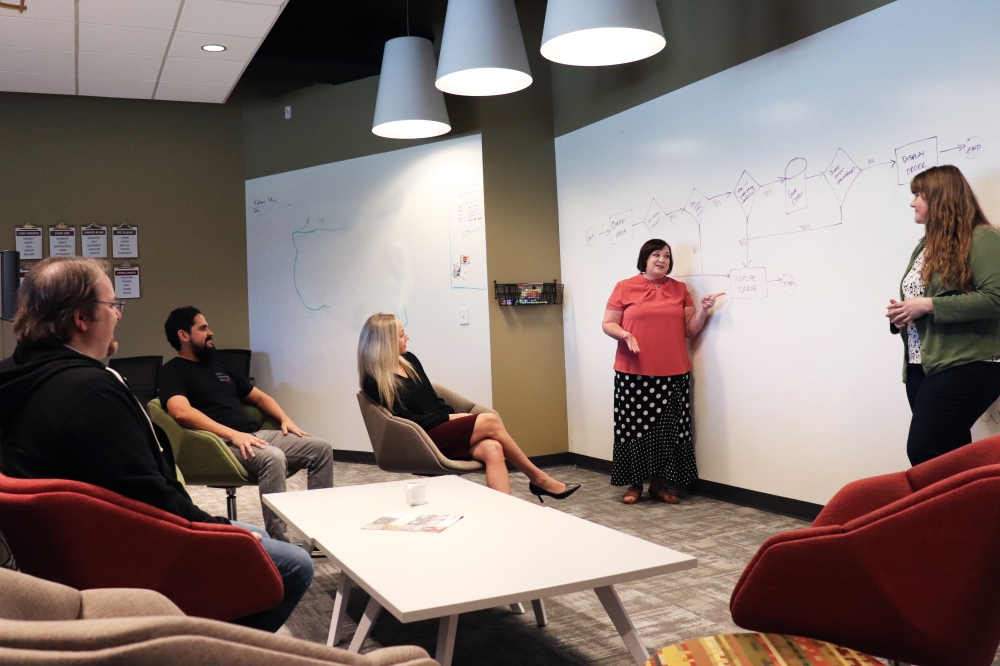With its novel approach, the news company carved out a unique opportunity for success using a combination of high-quality journalism, targeted advertising and visual storytelling delivering to all residences in its service areas for free.
The problem? The technology to support its model did not exist. The journey toward a database that could integrate and automate the company’s various streams of information took more than a decade to create.
After multiple iterations and evolutions, the custom-built software known as Community Impact Information Management System (CIIMS) now functions as the central hub for the company’s advertising, design, digital and editorial departments.
The journey to CIIMS
After 17 years with the company, Chief Operating Officer Claire Love is enjoying the fruits of her labor as the pioneer of CIIMS, but in 2006, she could be found planning out newspaper content using dry-erase markers.
At the time, Community Impact was just launching its second newspaper and the sales team had to manually enter information into Excel spreadsheets to keep track of the advertising details.
On the editorial side, newsroom staff used dry-erase markers and whiteboards to build out the mock-ups, known as dummies, for the upcoming newspaper edition.
“We had our dummies all built out and sitting on a windowsill, and then the cleaning crew came in,” Love said. “The boards got erased, and back then, we weren’t taking pictures or backing things up in the cloud, so we had to completely start over.”
Love recognized the acute need for software that could automate processes and integrate data shared between the newsroom, design, sales, circulation and finance teams. In 2016, with the addition of the printing press, CIIMS would integrate that data as well.
She had a general understanding of databases, but building a custom system would be a long and difficult process.
The first attempt
“We needed a new software system,” Love said. “What we needed didn’t exist in the market...[and] we would be sacrificing the uniqueness of our company to get [existing systems] to work for us. We needed to build this ourselves.”
Love said when she first approached CEO John Garrett with the idea, he thought it was crazy, but wanted to give it a chance.
Before taking the plunge, he wanted to see what automation could do for one aspect of the business, and how it could benefit the company as a whole. He asked Love to pick one department to pilot automation.
16 hours to 15 seconds
Love chose to work on one of the more complicated aspects of the company’s business model. In doing so, the automation took a process that averaged 16 hours to complete down to 15 seconds.
Garrett said automating this process was a huge sigh of relief, not only because it was fast, but because it relieved the pressure of only one person knowing how all the pieces fit together.
After successfully automating the task, Claire and her team continued to build CIIMS, eventually integrating every department of the company.

CIIMS 2.0
In 2019, Community Impact partnered with a consulting firm to create a new, online version of CIIMS and launched the new version of the software in 2020. After the launch, the company moved the work in-house, where its own software team took over and continued to develop the system into what it is today.
The software created numerous efficiencies and made data accessible to different company departments, Love said.
Now, CIIMS comprises all of Community Impact’s processes including contact management, order entry, billing, ad design management and pagination. On the printing side, CIIMS has grown to include everything from order management to how the newspaper shipments go out each day to the post offices.
“Many out of the box solutions have been tried over the years, all were found inadequate for our needs,” Development Manager Jennifer Bland said. “ ... So, CIIMS was born and the benefits were immediately felt. Innovation within the system hasn’t stopped and won’t stop.”
Love said most companies can find off-the-shelf systems that work for their needs and that the idea of creating a custom-built software is not only uncommon, but one that few would entertain.
As for Community Impact, the development of CIIMS is a testament to the company’s drive for efficiency and passion for innovative solutions, she said.
While other developers opened the door for ideation, they couldn’t necessarily make the company’s ideas come to life. Now, Community Impact not only has its own custom-built, in-house software, it also boasts a “best of the best” development team, Love said.
In the future, the system may even incorporate an AI element over its data set, Garrett said.
“I’m excited to add an AI element ... I see it being a big competitive advantage as our industry continues to change quickly,” Garrett said.






